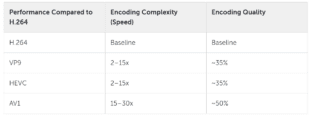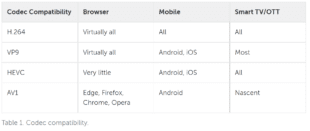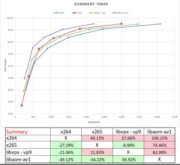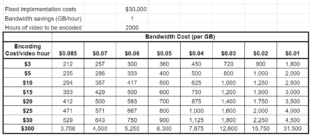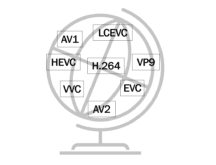This article on the Wowza website provides a quick overview of the VP9 codec: what it is, how it performs, what it costs, and what it’s good for. It concludes with a section on where you should consider deploying VP9 and what you need to know to effectively deploy the codec. The article is the second in a five-part series …
Read More »H.264 Codec Backgrounder
This article on the Wowza website provides a quick overview of the H.264 codec: what it is, how it performs, what it costs, and what it’s good for. It concludes with a section on what you need to know to effectively deploy the H.264 codec, particularly within the Wowza Streaming Engine software and the Wowza Streaming Cloud service. The article …
Read More »Real-World Bandwidth Savings from VP9, HEVC, and AV1
This article is about a video lesson that computes the bandwidths savings afforded by the FFmpeg-based implementations of VP9 (libvpx-VP9), H.264 (x264), HEVC (x265), and AV1 (libaom-AV1). The lesson uses the Netflix convex hull analysis to build unique encoding ladders for each test clip and codec and shows why BD-Rate figures don’t accurately predict real-world savings. Towards the end, it …
Read More »LCEVC Excels in Full Ladder Live Use Case Testing
Pleased to announce my second report on LCEVC Technology entitled LCEVC x264 Report: Live Sports & eGames, ABR Ladder. The first report assessed VOD performance at 1080p; this report tested live performance using a full encoding ladder and weighted average performance as well as BD-Rate comparisons. Here’s the Table of Contents. Note, in particular, the GB Tech report in the …
Read More »Webinar: Video Codecs in 2021 and Beyond with Jan Ozer
I was honored to present a free webinar entitled Video Codecs in 2021 and Beyond with Muvi on April 8, 2021. The slides and recording are below. Here’s the description. There has never been a time where so many video codecs were available (or soon to be available) for video producers. From MPEG, we have AVC (H.264), HEVC (H.265), VVC …
Read More »Computing Breakeven on New Codec Deployments
This article and the associated Google Sheet present an analytical model for computing breakeven on new codec deployments. On a LinkedIn post here, Johan Skaneby asked: Technical comparisons and documentation on different codec performance are very interesting and important, but all development of technologies are always closely related to market requirements and business models. My experience is that the challenge …
Read More »Beginner’s Guide to Codecs
This post provides an introduction to video codecs. It’s an entry-level article designed to help streaming newbies understand what codecs are, what they do, how to compare them, and why they succeed or fail. Video codecs are compression technologies that reduce the bitrate of digital video to manageable sizes. Video codecs are not only central to streaming, but they’re also …
Read More »Codec-Related Articles on the Streaming Learning Center
Here are some of the most popular codec-related articles that I’ve written lately for this site, Streaming Media Magazine, and some other outlets. General The Streaming Codec Landscape in 2021 – (January 2021) By any measure, 2020 was a hectic year for video codecs or the compression technologies that drive streaming video. This year saw the launch of two standards-based codecs …
Read More »Google Adding HEVC Playback to Chrome? Seems like a Longshot
I recently received the following message from a colleague, a respected IP attorney, on LinkedIn. Hi Jan, hope all’s well. What do you make of Google joining HEVC Advance’s pool (now Access Advance)? Talking to some relevant players, I think it’s a prelude to Chrome supporting HEVC. Do you think it has any implications for AV2 or VVC? Thanks, and …
Read More »New AV1 Training Course Teaches How To Encode with AV1
A new Streaming Learning Center Course, Encoding with the AV1 Codec, teaches how to optimize AV1 encoding with four AV1 codecs (aomenc, libaom-av1, SVT-AV1, Aurora1). Available now for $99.95. If you’re looking for a structured AV1 training program to learn how to encode with AV1, this is it. Click here for more information or to purchase the course. The AV1 …
Read More » Streaming Learning Center Where Streaming Professionals Learn to Excel
Streaming Learning Center Where Streaming Professionals Learn to Excel


